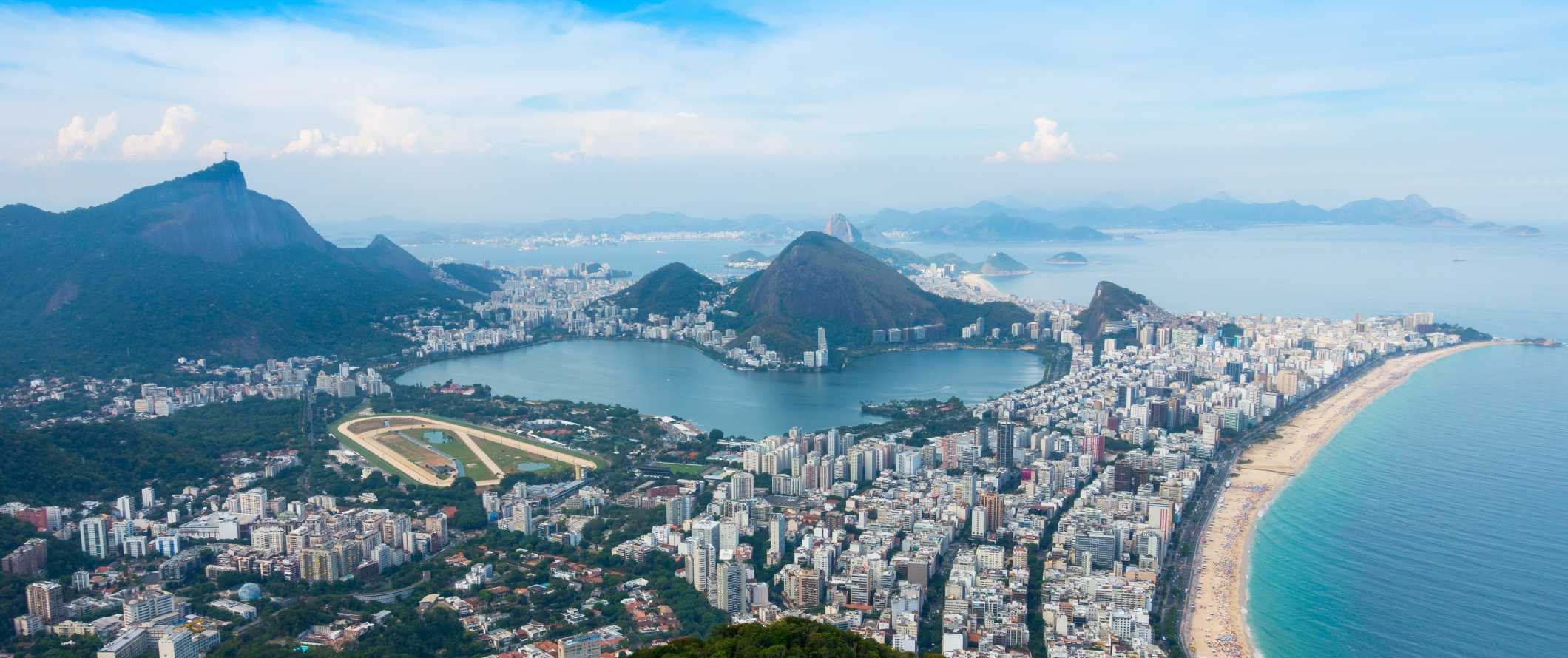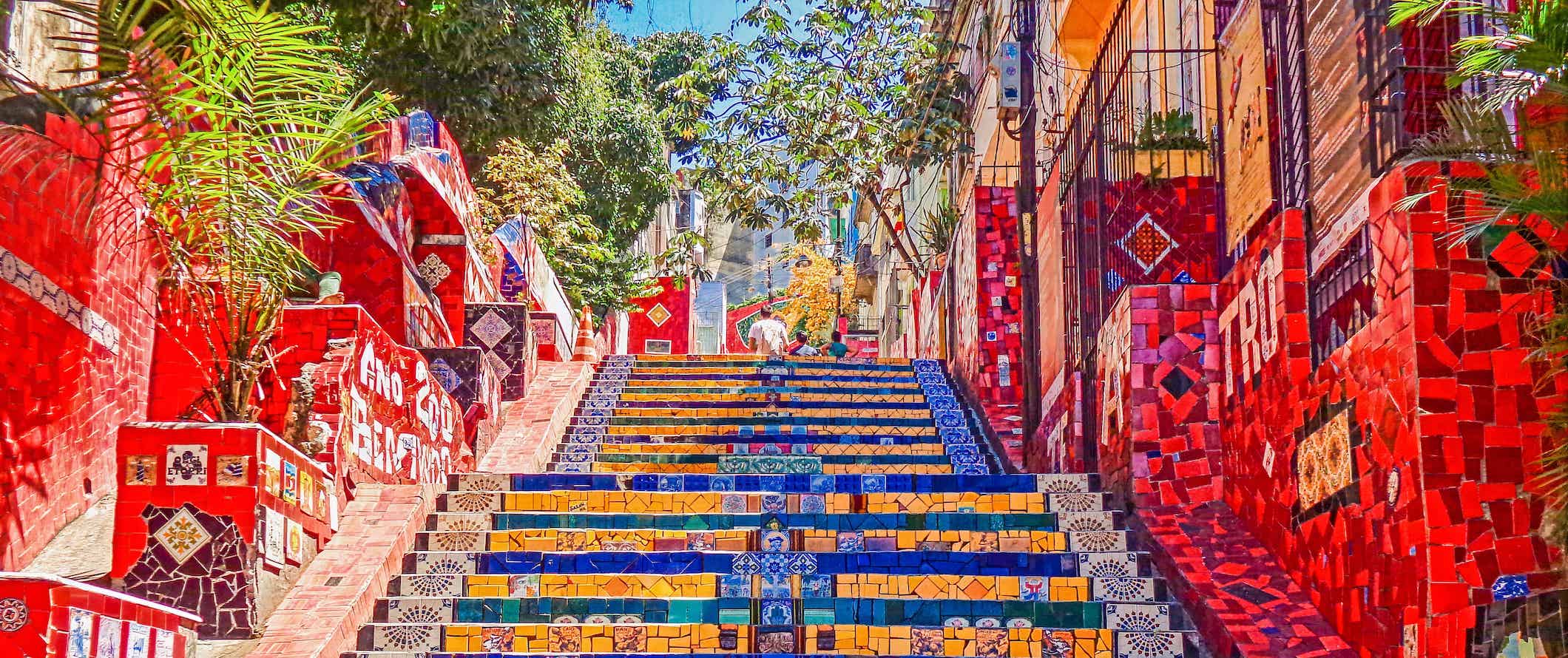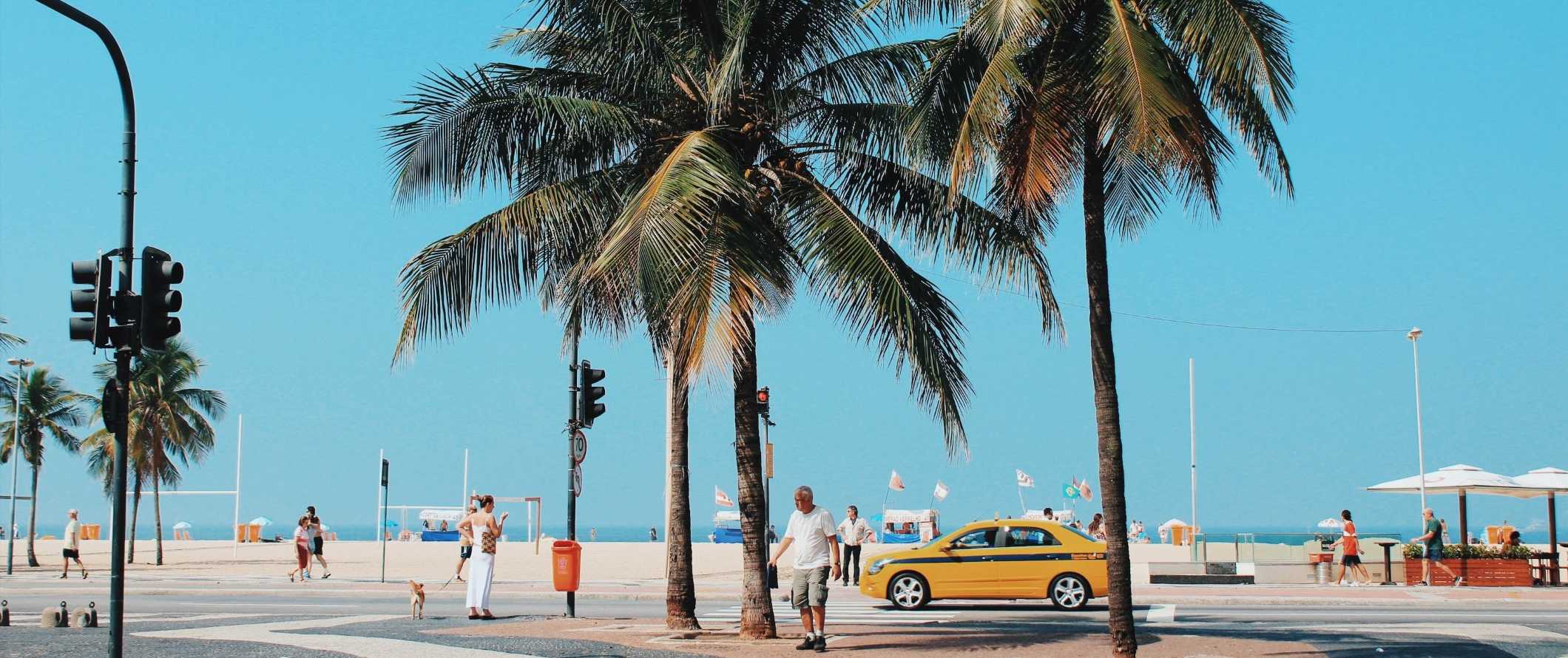From the world-famous beaches of Copacabana and Ipanema to the magnificent summit of Corcovado, topped with the legendary Wonder of the World Christ the Redeemer, Rio combines big natural attractions with a sprawling metropolis. Home to over 12 million people, it should come as no surprise that it’s one of the most popular destinations in the world.
Founded by the Portuguese in the 16th century, Rio de Janeiro caters to every type of tourist and budget, popular with backpackers, Carnival revelers, and luxury vacationers alike. It’s an exciting city that has a lot to offer — so don’t rush your visit. There’s too much to see, especially when you factor in all those lazy days at the beach!
While petty theft and crime are a big concern here (you’ll want to avoid walking around alone at night), with a little vigilance you’ll be able to enjoy your time in this vibrant city without too much worry.
This travel guide to Rio de Janeiro can help you save money, stay safe, and ensure you have a wonderful visit.
Table of Contents
Top 5 Things to See and Do in Rio de Janeiro
1. Celebrate Carnival
The Rio Carnival is one of the most famous festivals in the world, with people coming together from all corners of the globe to see the parade, listen to samba music, dance in the streets, and party for days. The city comes alive as thousands of people celebrate in bright, exotic regalia. You can reserve your 2024 Carnival tickets in advance here (highly recommended – they sell out quickly)!
2. Climb Sugarloaf Mountain
The famous Sugarloaf Mountain is one of the city’s most popular tourist destinations. Its name dates to the 16th century (the height of Brazil’s sugarcane trade), named for its resemblance to a conical block of sugar. The mountain is 396 meters (1,300 feet) tall, and at its peak, the entire city unfolds below you with spectacular views of Ipanema and Guanabara Bay, especially at sunset or sunrise. The cable car to get there costs 150 BRL (reserve online in advance to skip the often super long lines).
3. See Christ the Redeemer
The 30-meter (100-foot) high statue of Christ the Redeemer sits atop the Corcovado Mountain and can be seen from any point in Rio. From its vantage point, you can take in the mountains, the bay, and the entire cityscape from the favelas to the skyscrapers. It’s an incredible Wonder of the World! You can get there a few different ways: via cog train (that goes through the rainforest), shared vans that leave from designated points around the city, or by hiking the (quite steep) trail to the top (though for safety reasons, it’s not recommended to do the trail alone). You can reserve advance tickets for the train and statue here (155 BRL).
4. Hit the beaches
Ipanema and Copacabana are the two largest beaches, and they’re always jam-packed with people. Ipanema has more upscale restaurants and nightlife, while Copacabana has more things to do (like fishing, surfing, and beachside markets selling handicrafts and swimwear). For quieter spots, check out Barra de Tijuca Beach, Prainha Beach, or Leme Beach (at the further end of Copacabana Beach).
5. Watch a fútbol game
Fútbol (soccer) is a religion here, and the chaos and excitement during a match are contagious! Maracanã in Rio de Janeiro is one of the largest stadiums in the world, and it seats 100,000 supporters. The best games are the local teams (Flamengo, Vasco, Botafogo, and Fluminese). Tickets can be as low as 20 BRL. If you’re not in town during a game or want to learn even more about the sport and stadium, you can take a stadium tour for 77 BRL.
Other Things to See and Do in Rio de Janeiro
1. Visit the Botanical Gardens
For a moment of calm, head to the city’s botanical gardens. Walk along the meandering paths and trails or take a free guided tour of the gardens. This place is home to over 8,000 plant species, designed in 1808 by order of the Prince Regent Dom João. Highlights include a lake filled with enormous Vitória Régia water lilies, an enclosed area with over 600 species of orchids, and a carnivorous greenhouse filled with Venus flytraps and pitcher plants. The gardens get super busy with families on the weekends, so come during the week. Admission is 67 BRL.
2. Wander the Rio de Janeiro Zoo
If your travels don’t include a trip to the Amazon, you can still experience Brazil’s indigenous animals at the Rio City Zoo. Over 1,300 animals from 350 species live here, including many rare and endangered native species such as harpy eagles, maned wolves, golden-headed lion tamarins, anteaters, and more. There’s also a particularly impressive reptile house and open aviary with macaws, toucans, and tropical birds flying freely around. Admission costs 47 BRL.
3. Learn the samba
You’ll hear samba music playing endlessly around Rio, especially during Carnival. Rio de Janeiro is one of the best places in Brazil to learn how to dance. Rio Samba Dancer is my favorite for its all-levels group classes, especially for the classes combined with social outings to samba clubs. Classes start from about 105 BRL.
4. Go to Paquetá Island
Paquetá Island in Guanabara Bay is a favorite with locals for escaping the hustle and bustle of the city center on weekends. The island is an hour-long ferry ride from Rio, and it’s made up of mainly beaches and quaint colonial towns. Transportation around the island is only by foot, bicycle, or horse-drawn carts. There’s not a lot to do here, but that’s kind of the point. The ferry costs 6.50 BRL one-way.
5. Ride the Santa Teresa tram
This tram has been running through the Santa Teresa neighborhood since 1877, making it the oldest electric railway in Latin America. It has always followed the same route from the city center, across the Lapa Arches, and passing by Ruinas Park overlooking Rio. The tram is open-sided, meaning you can lean out over the arches (a narrow former aqueduct) as you cross them – it’s a dizzying view! A return ticket on the 6-kilometer (3.7-mile) route is 20 BRL.
6. Visit the Selaron Stairway
Located in the Santa Teresa neighborhood, this stairway has hundreds of steps all painted with more than 2,000 pieces of colorful tiles, mosaics, and mirrors. Starting in the early 1990s, artist Jorge Selarón began gathering contributions from artists in 60 different countries. He also visited antique shops and trash heaps to find pieces to add over time, working on the staircase’s construction for over 20 years until his death in 2013. It’s one of the most photogenic and popular sights in the city (you’ve probably seen it on Instagram) so don’t miss it!
7. Explore the Arcos da Lapa district
For those of you who love the nightlife, this is an awesome district to head out to on a Friday night. Bars, clubs, and food stalls dominate the area, and street parties run from the famous arches up Avenida Mem de Sá. For live music, go to Circo Voador, an open-air concert venue primarily featuring Brazilian bands and artists. If you want to experience the club scene, check out the three-story Rio Scenarium. If you’re not into partying at all, admire the photogenic Arcos de Lapa (Lapa Arches). These arches date back to the mid-18th century and were once used as aqueducts.
8. Visit Sitio Roberto Burle Marx
This home and World Heritage Site belongs to one of Brazil’s most celebrated landscape designers, Roberto Burle Marx. Begun in 1949 and developed over the course of over 40 years, this 100-acre property features over 3,500 tropical and subtropical plant species. Inside the Burle Marx House Museum is a huge collection of his personal artwork as well as a 17th-century Benedictine chapel. Tours cost 10 BRL and are available by appointment only.
9. Visit the São Bento Monastery
Built between 1617-1641, this colonial Baroque church is located on Morro de São Bentois (St. Benedict Hill) in downtown Rio de Janeiro. Although the exterior is simple, the inside is covered in gold decoration, wood carvings from Frei Domingos da Conceição and Alexandre Machado, and paintings from José de Oliveira Rosa. The monastery is still in operation today, and if you attend Sunday mass, you’ll get to hear some traditional Gregorian chanting. Just be sure to dress respectfully as it is a place of worship.
10. Hike in Tijuca National Park
Tijuca National Park is the largest urban rainforest in the world, stretching across 8,300 acres. Over 350 different species of mammals, birds, and reptiles make their home here, including howler monkeys, which only came back to the park recently after a 100-year hiatus. The Corcovado (Christo) hike through Parque Lage and to the top of Corcovado is a steep climb, but it’s shaded and only takes about three hours. Another scenic hike is to Tijuca Peak, starting in Rio’s North Zone and past waterfalls and dense rainforest. You’ll get views over Niteroi and Guanabara Bay, and it only takes about two hours to complete. Entrance to the park is free. This is a place where it’s really worth it to go with a tour though. You’ll not only have a more in-depth experience, learning history of the rainforest as well as how to recognize native flora and fauna, but get round-trip transportation to/from your accommodation as well. There are tons of tours available, from the popular jeep tours to full-day adventure hikes that go to lesser visited sections of the rainforest.
11. Go to the Ilha Fiscal
A little outside Rio’s city center is Ilha Fiscal, a Neo-Gothic castle on a secluded island in Guanabara Bay. It used to be a location for the Brazilian Custom Service but is now a work of architectural art, with mosaic floors, stained glass, and a traditional Ceremonial Room used by the Navy. You can only access the island by schooner and bus from the Naval Museum. Admission to the Naval Museum is free, while a return ticket to Ilha Fiscal is 42 BRL.
12. Visit the Museum of Tomorrow
The Museum of Tomorrow (Museu do Amanhã) is a science museum that focuses on ecology, sustainability, and the future of our planet. Ultra-sleek and modern, the Museum of Tomorrow has high-tech visuals and simulators that let you consider the world’s past, present, and future. Although it might sound depressing, it’s incredibly well-curated, and the whole experience is captivating. Admission is 30 BRL.
13.Take a walking tour
Walking tours are my favorite way to get my bearings in a new place. Free Walker Tours and Rio by Foot both offer free walking tours through a variety of different Rio neighborhoods, as well as paid tours such as food tours, pub crawls, and rainforest tours. If you’re taking a free tour, just be sure to tip your guide at the end!
14. Explore Rio by Bike
Because of Rio’s geography, stretching along the coast between the ocean and the mountainous rainforest, the city can take some time to get around. You can cover a lot of ground by biking along the beach and through different neighborhoods on the many kilometers of dedicated bike lanes in the city. You can either explore on your own or with a local guide on a tour with Rio by Bike.
For more information on other cities in Brazil, check out these guides:
Rio de Janeiro Travel Costs
Hostel prices – Large dorm rooms with 8-10 beds start around 65-75 BRL per night. Dorm rooms with 4-6 beds are around 90-110 BRL per night. Standard twin or double private rooms cost 225-300 BRL per night for two people.
Free Wi-Fi is standard, and most hostels have a bar and outdoor patio with a BBQ. Free breakfast is usually included at hostels in Rio de Janeiro, and kitchen facilities are common too. Some hostels have a pool, coworking spaces, and bikes for rent.
If you book your bed well ahead of time for Carnival (at least six months), you’ll have more options. However, prices skyrocket — some of those dorms mentioned above increase to 200-300 BRL per night — during Carnival!
Budget hotel prices – A double room in a basic two-star hotel is around 150 BRL per night in the city center, including a private bathroom and balcony as well as free Wi-Fi. That price can nearly double in other places like Copacabana (the most popular place for tourists to stay).
A budget hotel with more amenities (free breakfast, a swimming pool, bar/restaurant) starts around 190 BRL per night for a double room.
Airbnb is another affordable option here. For a private room, expect to pay about 100-125 BRL per night, while you can find a comfortable home or apartment for about 275-350 BRL per night.
During Carnival time, private and hotel rooms can double in price and sell out fast.
Average cost of food – Brazilian cuisine – like the country itself – is a mix of many cultures, with European, Amerindian, African, and (more recently) Japanese influences. As such a large country, food varies per region, with seafood plentiful on the coastlines and Brazilian barbecue dominating plates in the south. Rice and beans are a staple throughout the country.
Common vegetables include tubers like cassava and yams, tomatoes, red peppers, okra, and more. Being a subtropical country, there’s a huge variety of fruits, with the most famous being the superfood açaí. Cupuaçu, mango, papaya, guava, orange, passion fruit, pineapple, are all commonly found in smoothies and fresh juices across the country.
Look for feijoada on the menu. It’s Brazil’s national dish, a meaty bean stew, traditionally eaten for Wednesday or Saturday lunch. Other popular dishes include moqueca (fish stew), polenta, vatapá (a stew of bread, shrimp, coconut milk, and peanuts), and farofa (toasted cassava flour, served as a side to feijoada), among countless others.
Some popular street food snacks include pão de queijo (cheese bread rolls), acarajé (black-eyed pea and shrimp fritters), coxinha (chicken croquettes), and pastéis (savory fried pies with assorted fillings). In Rio, bolinhos de bacalhau (fried cod fritters) are especially popular due to the city’s coastal location.
Rio de Janeiro has lots of affordable food options, with street food like pastels, coxinha, and tapiocas costing 8-10 BRL each. A meal at an inexpensive restaurant serving typical Brazilian dishes costs about 20-40 BRL. An açaí (served pureed and frozen, with toppings you can choose from) from a street stand or takeaway spot is 15-20 BRL.
For fast food, a combo meal at McDonald’s or a takeaway meal from a Chinese restaurant both cost about 35 BRL.
A meal with two courses at a casual restaurant starts from 60 BRL, though prices at restaurants along the beach can go much higher, starting around 70-80 BRL for a dish. A three-course meal with a drink at a nicer restaurant is around 200 BRL.
A beer to go with your meal is around 7-10 BRL, while a cocktail starts at 20 BRL (though they can get upwards of 40 BRL in fancier places). In terms of non-alcoholic drinks, a cappuccino or fresh juice is 8-12 BRL.
One of the best ways to eat in Rio is to find a restaurant por kilo, which lets you pay for your meal by weight (so skip the super-thick steak). It generally costs around 70-90 BRL per kilo, with prices varying depending on the time of day and day of the week (nights and weekends are more expensive). Restaurante Temperarte near Copacabana is a great option for trying this.
Grocery shopping is very cheap, costing about 100-145 BRL per week for bread, meat, veggies, and other basics. You’ll just need to make sure you book accommodation with a kitchen.
Backpacking Rio de Janeiro Suggested Budgets
If you are backpacking Rio de Janeiro, expect to spend about 215 BRL per day. This covers staying in a hostel dorm, eating street food, cooking some of your meals, limiting your drinking, using public transportation to get around, and doing mostly free activities like enjoying the beach.
On a mid-range budget of about 470 BRL per day, you can stay in a private hostel or Airbnb room, eat out for all your meals at cheap local restaurants, take the occasional taxi to get around, enjoy a few drinks, and do more paid activities like visiting the zoo and attending a soccer game.
On a “luxury” budget of about 825 BRL per day or more, you can stay in a hotel, eat out for all your meals, enjoy more drinks, take taxis everywhere, and enjoy all the tours and activities you want. This is just the ground floor for luxury though. The sky is the limit!
If you’re coming during Carnival time, expect prices for accommodations and activities to increase significantly (sometimes quadruple) — especially if you’re booking last minute.
Rio de Janeiro Travel Guide: Money-Saving Tips
Rio has lots of free activities and attractions to enjoy, like beaches and hiking trails. While food and accommodation aren’t cheap, there are ways to keep your costs down. Here are some ways to save money in Rio de Janeiro:
- Eat por kilo – As with elsewhere in Brazil, restaurants that have you pay by the kilo for your food is a good deal. Look out for these cheap options.
- Visit the market – If you’re staying at a hostel with kitchen facilities, it’s a good idea to stock up on food at the market and eat like the locals.
- Snack on street food – There’s a thriving street food culture in Brazil, meaning lots of cheap and delicious food to fill up on.
- Stay with a local – Couchsurfing connects you with locals who can give you a free place to stay and share their insider tips and advice. It’s the best way to meet locals and save money.
- Go to free museum days – Almost all the museums in Rio have a free day to visit each week. Check their website for details!
- Take a free walking tour – There are many excellent free walking tours in Rio, including Free Walker Tours and Rio By Foot. They’re the best way to see the main sights on a budget. Just be sure to tip your guide at the end!
- Avoid Carnival time – As exciting as Carnival is, visiting Rio any other time of the year is just as magical and saves you lots of money.
- Pack a water bottle – The tap water here isn’t safe to drink so bring a water bottle with a filter to save money and reduce your single-use plastic usage. My preferred bottle is LifeStraw as it has a built-in filter to ensure your water is always clean and safe.
Where to Stay in Rio de Janeiro
Rio de Janeiro is a sprawling city. When you’re researching your hostel, make sure you find a neighborhood that fits your needs, whether you want to stay in the city center or somewhere near the beach. Otherwise, you’ll be spending a lot of money on taxis and sitting in the city’s terrible traffic. Here are my suggested places to stay:
For more suggestions, check out this post on the best hostels in Rio.
How to Get Around Rio de Janeiro
Public Transportation – Rio’s BRT (Bus Rapid Transit) has quick and reliable routes in Copacabana, Barra, Ipanema, and Leblon. Fares cost from 3.80 BRL per trip. You’ll have to flag down a bus by waving at the driver. Otherwise, the Metrô Na Superfície shuttle passengers between metro stations, but they’re often very crowded. The bus is also not always the safest method of travel, so exercise caution here, and don’t use them at night.
Rio de Janeiro has three very efficient subway lines. Line 1 runs between Ipanema to the North Zone, while Line 2 runs between Botafogo and Pavuna (with Maracanã football stadium on the way). Line 3 runs between Ipanema and the Barra de Tijuca. You can get a prepaid card (called RioCard+Mais) at any kiosk for 4 BRL. A single metro ride costs 5 BRL.
For solo female travelers, note that there are women-only metro cars (marked in pink) during peak rush hours (6am-9am, 5-8pm, on weekdays).
The only remaining tram line in Rio is the famous Santa Teresa line, which runs from the tram station in Centro and travels across the Lapa Arches, Ruinas Park, and then turns around at Largo do Guimarães. A return ticket is 20 BRL.
Bicycle – Rio has tons of bike paths along its main beach areas. Unfortunately, only Brazilian citizens and residents with a CPF number can use the bike sharing system, though you can also rent bikes from a local shop for about 150 BRL per day to navigate the paths between Copacabana and Ipanema.
Ferry – You can take a ferry to visit several of Rio’s highlights, like Ilha Fiscal, Ilha de Paquetá, and Niterói. Ticket prices are generally 12-15 BRL round-trip.
Taxis – Taxis start at 6 BRL and cost an additional 2.65 BRL per kilometer. This rate increases to 3 BRL per kilometer at night and on Sundays. A ride around town generally costs 10-50 BRL.
Use the 99 app (formerly 99Taxis) to get a safe, metered taxi.
Ridesharing – Uber is available in Rio de Janeiro and usually costs around the same a taxi.
Car rental – Renting a car generally costs 80-120 BRL per day, though I don’t recommend renting a car here. It’s unnecessary, the traffic is terrible, drivers are aggressive, and parking is expensive. Break-ins and carjackings are common.
When to Go to Rio de Janeiro
December to March is when Rio is at its warmest and sunniest. There isn’t much rain during these months, and temperatures tend to be around 32°C (90°F) and higher each day.
Autumn (April-May) and spring (October-November) offer slightly cooler temperatures, usually in the mid-20s°C (low 80s°F). Although Rio is busy year-round, you’ll avoid a lot of peak tourism madness by visiting during these months.
During February’s Carnival, prices skyrocket, and accommodation sells out very quickly. You should consider booking your travel at least six months (and up to a year) before Carnival time to snag the best deals and places to stay.
How to Stay Safe in Rio de Janeiro
Rio de Janeiro has a lot of crime and is not the safest city in the world. Violent attacks can occur, however, your biggest concern here is petty crime — especially after nightfall around popular tourist destinations.
Don’t walk alone at night. Instead, take taxis. Have your accommodation call one for you so you can be sure you get a reputable driver.
When withdrawing money, make sure you go inside a bank so that you can put your cash away without the risk of getting robbed.
Don’t flash your valuables and always make sure your possessions are secure and out of reach (especially your phone and wallet).
Never accept drinks from strangers and don’t leave anything unattended at the beach.
Unless you’re on a guided tour, avoid the favelas. The favelas are where the highest rate of crime occurs in the city, and you shouldn’t be exploring there on your own.
Carjacking and break-ins are common so avoid renting a car here.
Solo female travelers will want to exercise caution here. Travel with groups where you can and avoid getting too far off the beaten path if you’re alone.
If you’re worried about getting scammed, you can read about common travel scams to avoid right here.
If you experience an emergency, dial 190 for assistance.
Always trust your gut instinct. Avoid isolated areas at night and be aware of your surroundings at all times. Make copies of your personal documents, including your passport and ID. Forward your itinerary along to loved ones so they’ll know where you are.
The most important piece of advice I can offer is to purchase good travel insurance. Travel insurance will protect you against illness, injury, theft, and cancellations. It’s comprehensive protection in case anything goes wrong. I never go on a trip without it as I’ve had to use it many times in the past.
Rio de Janeiro Travel Guide: The Best Booking Resources
These are my favorite companies to use when I travel. They consistently have the best deals, offer world-class customer service and great value, and overall, are better than their competitors. They are the companies I use the most and are always the starting point in my search for travel deals.
- Skyscanner – Skyscanner is my favorite flight search engine. They search small websites and budget airlines that larger search sites tend to miss. They are hands down the number one place to start.
- Hostelworld – This is the best hostel accommodation site out there with the largest inventory, best search interface, and widest availability.
- Booking.com – The best all around booking site that constantly provides the cheapest and lowest rates. They have the widest selection of budget accommodation. In all my tests, they’ve always had the cheapest rates out of all the booking websites.
- Get Your Guide – Get Your Guide is a huge online marketplace for tours and excursions. They have tons of tour options available in cities all around the world, including everything from cooking classes, walking tours, street art lessons, and more!
- SafetyWing – Safety Wing offers convenient and affordable plans tailored to digital nomads and long-term travelers. They have cheap monthly plans, great customer service, and an easy-to-use claims process that makes it perfect for those on the road.
- LifeStraw – My go-to company for reusable water bottles with built-in filters so you can ensure your drinking water is always clean and safe.
- Unbound Merino – They make lightweight, durable, easy-to-clean travel clothing.
- Top Travel Credit Cards – Points are the best way to cut down travel expenses. Here’s my favorite point earning credit cards so you can get free travel!
Rio de Janeiro Travel Guide: Related Articles
Want more info? Check out all the articles I’ve written on backpacking/traveling Brazil and continue planning your trip:





